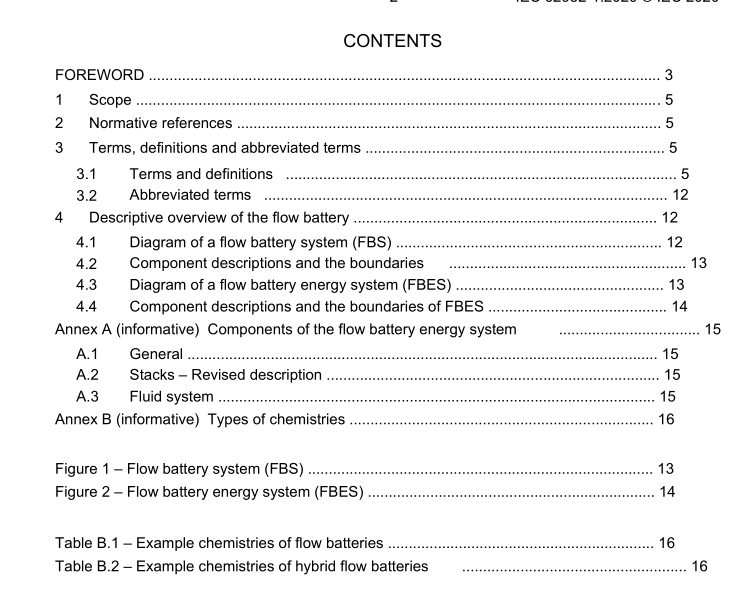IEC 62932-1 pdf – Flow battery energy systems for stationary applications – Part 1: Terminology and general aspects

IEC 62932-1 pdf – Flow battery energy systems for stationary applications – Part 1: Terminology and general aspects
1 Scope
This part of lEC 62932 relates to flow battery energy systems (FBES) used in electrical energy storage (EES) applications and provides the main terminology and general aspects of thistechnology, including terms necessary for the definition of unit parameters, test methods,safety
and environmental issues.
Normative references
There are no normative references in this document.
3 Terms,definitions and abbreviated terms
3.1Terms and definitions
For the purposes of this document, the following terms and definitions apply.
ISo and IEC maintain terminological databases for use in standardization at the followingaddresses:
.IEC Electropedia: available at http://www.electropedia.orgl
.Iso Online browsing platform: available at http://www.iso.orglobp
3.1.1
ambient temperature
environmental temperature around a flow battery energy system
3.1.2
auxiliary energy
energy consumed by all the auxiliary equipment and components of a flow battery and of a flowbattery energy system Note 1 to entry: The equipment and components include,but are not limited to, battery management system, baterysupport system. fluid circulation system.
3.1.3
battery management systemBMS
electronic system associated with a flow battery energy system which monitors and/or manages
its state,calculates secondary data,reports that data and/or controls its environment toinfluence the flow battery energy ‘system’s performance and/or service life
Note 1 to entry: The function of the battery management system can be fully or partally assigned to the balterypack and/or to equipment that uses flow battery energy store systems.
[SOURCE:IEC 61427-2:2015,3.8, modified – admitted terms “battery management unit”and”BMU” omitted, “battery” replaced by “flow battery energy system”,Notes 2 to 4 deleted.]
3.1.4
battery support systemBss
auxiliary units, such as heat exchanger,ventilation system, safety system, and inert gas system,
used in an FBES, and which are not stacks,or part of the fluid circulationsystem, powerconversion system, or battery management system
Note 1 to entry: The battery support system is controlled by the battery management system.3.1.5
chargecharging
Note 1 to entry: A charge operation is defined by its maximum voltage,current,duration and other conditions asspecified by the manufacturer.”
[SOURCE: IEC 60050-482:2004,482-05-27, modified – term “charging of a battery” separatedinto “charge” and “charging” with “of a battery” as the domain, and addition of the note.]
3.1.6
cold standby
standby state requiring warm up before a demand to operate can be met
Note 1 to entry: A cold standby state may apply to redundant or stand-alone items.
Note 2to entry. In this context “wam up”includes meeting any conditions required to operate as required (e.g.achieving the required temperature,speed,pressure).
[SOURCE: IEC 60050-192:2015,192-02-11, modified – “state” omitted from the term, and thedomain, “of an item”, deleted.]
3.1.7
dischargedischarging
electrical energy
Note 1 to entry: A discharge operation is defined by its maximum voltage,current,duration and other conditions asspecified by the manufacturer.
3.1.8
emergency shutdown
rapid regulated shutdown of the flow battery energy system triggered by a protection system orby manual intervention
[SOURCE: IEC 60050-415:1999,415-01-11, modified – the word “regulated” added, and “windturbine” replaced by “flow battery energy system”.]
3.1.9
emergency stop
function which is intended to avert arising or reduce existing hazards to persons,damage tomachinery or to work in progress and be initiated by a single action
3.1.10
energy efficiency
usefulenergy output at primary PoC divided by the required energy input by the FBES/FBSincluding all parasitic and auxiliary energy needed to run the system and evaluated duringFBES/FBS operation with the same final state of charge as the initial state of charge
Note 1 to entry: The energy efficiency for FBES includes necessary conversion loss of power conversion system(PCS),auxiliaryenrgy required for fluid circulation system,BMS and BSS.
Note 2 to entry: Efficiency is generally expressed in percentage.
[SOURCE: IEC 62933-1:2018,4.12,modified – “EES”replaced by “FBES/FBS”,Note 1 toentry replaced.]
3.1.11
energy storage fluid
fluid that contains active materials and flows through the battery cell, consisting of liquid,suspension or gas
3.1.12
end of charge
limit conditions specified by the manufacturer at which a charge is (to be) terminated
3.1.13
end of discharge
limit conditions specified by the manufacturer at which a discharge is (to be) terminated
3.1.14
flow cell
secondary cell characterized by the spatial separation of the electrodes and the movement ofthe energy storage fluids
Note 1 to entry: Flow battery cell includes the hybrid flow cell.3.1.15
flow battery energy systemFBES
system to store energy consisting of FBS(s) and power conversion system(s)









